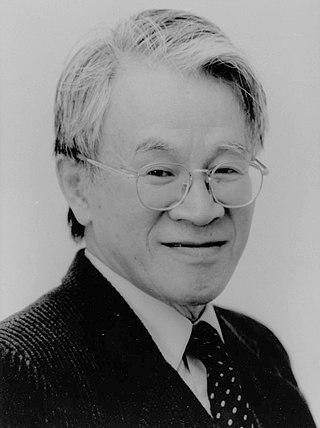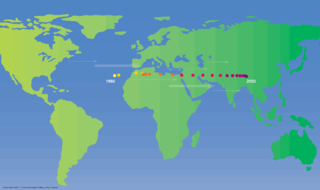
David Ricardo was a British political economist, politician, and member of the Parliament of Great Britain and Ireland. He is recognized as one of the most influential classical economists, alongside figures such as Thomas Malthus, Adam Smith and James Mill.
In an economic model, agents have a comparative advantage over others in producing a particular good if they can produce that good at a lower relative opportunity cost or autarky price, i.e. at a lower relative marginal cost prior to trade. Comparative advantage describes the economic reality of the work gains from trade for individuals, firms, or nations, which arise from differences in their factor endowments or technological progress.

Bertil Gotthard Ohlin was a Swedish economist and politician. He was a professor of economics at the Stockholm School of Economics from 1929 to 1965. He was also leader of the People's Party, a social-liberal party which at the time was the largest party in opposition to the governing Social Democratic Party, from 1944 to 1967. He served briefly as Minister of Commerce and Industry from 1944 to 1945 in the Swedish coalition government during World War II. He was President of the Nordic Council in 1959 and 1964.
In economics, internationalization or internationalisation is the process of increasing involvement of enterprises in international markets, although there is no agreed definition of internationalization. Internationalization is a crucial strategy not only for companies that seek horizontal integration globally but also for countries that addresses the sustainability of its development in different manufacturing as well as service sectors especially in higher education which is a very important context that needs internationalization to bridge the gap between different cultures and countries. There are several internationalization theories which try to explain why there are international activities.
Classical economics, classical political economy, or Smithian economics is a school of thought in political economy that flourished, primarily in Britain, in the late 18th and early-to-mid 19th century. Its main thinkers are held to be Adam Smith, Jean-Baptiste Say, David Ricardo, Thomas Robert Malthus, and John Stuart Mill. These economists produced a theory of market economies as largely self-regulating systems, governed by natural laws of production and exchange.
In economics, the cost-of-production theory of value is the theory that the price of an object or condition is determined by the sum of the cost of the resources that went into making it. The cost can comprise any of the factors of production and taxation.
Factor price equalization is an economic theory, by Paul A. Samuelson (1948), which states that the prices of identical factors of production, such as the wage rate or the rent of capital, will be equalized across countries as a result of international trade in commodities. The theorem assumes that there are two goods and two factors of production, for example capital and labour. Other key assumptions of the theorem are that each country faces the same commodity prices, because of free trade in commodities, uses the same technology for production, and produces both goods. Crucially these assumptions result in factor prices being equalized across countries without the need for factor mobility, such as migration of labor or capital flows.
In economics, the principle of absolute advantage is the ability of a party to produce a good or service more efficiently than its competitors. The Scottish economist Adam Smith first described the principle of absolute advantage in the context of international trade in 1776, using labor as the only input. Since absolute advantage is determined by a simple comparison of labor productiveness, it is possible for a party to have no absolute advantage in anything.

Michio Morishima was a Japanese heterodox economist and public intellectual who was the Sir John Hicks Professor of Economics at the London School of Economics from 1970–88. He was also professor at Osaka University and member of the British Academy. In 1976 he won the Order of Culture.

The Heckscher–Ohlin model is a general equilibrium mathematical model of international trade, developed by Eli Heckscher and Bertil Ohlin at the Stockholm School of Economics. It builds on David Ricardo's theory of comparative advantage by predicting patterns of commerce and production based on the factor endowments of a trading region. The model essentially says that countries export the products which use their relatively abundant and cheap factors of production, and import the products which use the countries' relatively scarce factors.
International economics is concerned with the effects upon economic activity from international differences in productive resources and consumer preferences and the international institutions that affect them. It seeks to explain the patterns and consequences of transactions and interactions between the inhabitants of different countries, including trade, investment and transaction.
New trade theory (NTT) is a collection of economic models in international trade theory which focuses on the role of increasing returns to scale and network effects, which were originally developed in the late 1970s and early 1980s. The main motivation for the development of NTT was that, contrary to what traditional trade models would suggest, the majority of the world trade takes place between countries that are similar in terms of development, structure, and factor endowments.
Leontief's paradox in economics is that a country with a higher capital per worker has a lower capital/labor ratio in exports than in imports.
The Linder hypothesis is an economics conjecture about international trade patterns: The more similar the demand structures of countries, the more they will trade with one another. Further, international trade will still occur between two countries having identical preferences and factor endowments.
Intra-industry trade refers to the exchange of similar products belonging to the same industry. The term is usually applied to international trade, where the same types of goods or services are both imported and exported.

The gravity model of international trade in international economics is a model that, in its traditional form, predicts bilateral trade flows based on the economic sizes and distance between two units. Research shows that there is "overwhelming evidence that trade tends to fall with distance."

Ricardian economics are the economic theories of David Ricardo, an English political economist born in 1772 who made a fortune as a stockbroker and loan broker. At the age of 27, he read An Inquiry into the Nature and Causes of Wealth of Nations by Adam Smith and was energised by the theories of economics.

Luigi L. Pasinetti was an Italian economist of the post-Keynesian school. Pasinetti was considered the heir of the "Cambridge Keynesians" and a student of Piero Sraffa and Richard Kahn. Along with them, as well as Joan Robinson, he was one of the prominent members on the "Cambridge, UK" side of the Cambridge capital controversy. His contributions to economics include developing the analytical foundations of neo-Ricardian economics, including the theory of value and distribution, as well as work in the line of Kaldorian theory of growth and income distribution. He also developed the theory of structural change and economic growth, structural economic dynamics and uneven sectoral development.
A global value chain (GVC) refers to the full range of activities that economic actors engage in to bring a product to market. The global value chain does not only involve production processes, but preproduction and postproduction processes.
The Ricardo–Viner model, also known as the specific factors model, is an extension of the Ricardo model used in international trade theory. It was due to Jacob Viner's interest in explaining the migration of workers from the rural to urban areas after the Industrial revolution. Unlike the Ricardian model, the specific factors model allows for the existence of factors of production besides labor. In other words, labor is mobile, while the two other factors of production are immobile as opposed to the Ricardian model where labor is immobile internationally, but mobile between two sectors of an economy.






